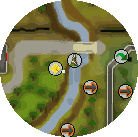The God Wars. A cataclysmic event that spanned an entire era of Runescape history. Four millenia of brutal fighting that left the world a withered husk of its former self. The beginning of the wars came when the Mahjarrat Zamorak beat the god Zaros in single combat, essentially usurping his position as god. Sensing their opportunity other gods lashed out, hoping to catch Zamorak off guard before he could consolidate his power to seize total control of Gielenor. Unfortunately Zamorak was ready for them, and what followed was four millenia of bloodshed that didn't end until Guthix himself awoke from his slumber.
Nowadays the God Wars are mostly forgotten. A select few still hold knowledge of the event, but they are by far the minority. The archaeologists seem to have no real interest in the Third Age beyond the gathering of knowledge. The church of Saradomin has cowed the general population, with seemingly only the highest ranking officials being aware of the full extent of the conflict. The guardians of Armadyl have gone largely underground. Goblins seem largely unaware of their role in the wars beyond serving their "Great High War God".
But despite the Edicts of Guthix that ended the God Wars, the gods still continue to manipulate life in Gielinor. Each god seems to have staked out claims to various territories and peoples. As proven by the events of Shadow of the Storm however, the Edicts of Guthix are no longer as binding as they once were. The barrier of the River Salve is waning. Mages loyal to Zamorak have repeatedly attempted to bring new, powerful demons back into the realm. The guardians of Armadyl have to struggle to hang onto the last remnants of their power. The influence of the Kharidian desert gods seems to be spreading. There is turmoil brewing beneath the (mostly) peaceful facade of Gielinor.
So let's assume that tomorrow the first blow is struck, and the Edicts of Guthix go out the window. The gods come out fighting, mobilizing their forces, tapping into their resources and digging into their trenches. Armies will need to be mobilized, fed and armed. Who will step into the fray? What will they bring to the fight? How will they be looking to secure their total domination? What role will those groups that seem to hold no divine allegiance play?
The Saradomist forces seem to hold an impressive amount of territory. The kingdoms of Misthalin and Asgarnia and the duchy of Lumbridge are firmly under their control, and while their hold on the kingdom of Kandarin isn't nearly as strong as they like to think they do seem to have some loyal outposts in the west. Each of their cities has a standing militia that is well supplied and armed, and they have a number of knightly orders throughout Gielinor. Their presence in the city of Ardougne, besides the aforementioned knights, includes paladins and heroes. However, their loyalties will be split between their king and their god and any Saradomist general would be a fool to place blind faith in their loyal participation in the conflict.
Their resources are bountiful. They hold the verdant farmlands surrounding Lumbridge, Draynor and Falador that produce plenty of wheat and vegetables. They have access to mines south of Lumbridge, inside the Barbarian Village, south of Varrock, north of Rimmington and south of Port Sarim. However, the most productive mines under Ice Mountain and in the mining guild are under dwarven control, and they have historically been highly protective of their treasured ores. One of their biggest advantages is their control of the production of runestones. Several figures that appear to be loyal to Saradomin hold the knowledge of access to the rune essence mines and most of the minor altars lie firmly within their territory. This means that the magical edge appears to be firmly on the Saradomist side.
Those loyal to Zamorak hold several territories. In the east, Morytania is home to werewolves, vampyres, ghasts and various powerful nasties. In the north the wilderness is now mostly desolate, but scattered across the wilderness there are still demons, chaos dwarves and several human groups that appear to be loyal to Zamorak. In the west, King Lathas of Ardougne has proven more than willing to collaborate with the forces of Zamorak to expand his kingdom. Beyond the mountains lies the Elven city of Priffdinas. Although they once worshiped the goddess Seren, the crystal city is currently under control of Lord Iowerth, leader of the Iowerth clan, who has pledged his allegiance to the god of chaos. At a moment's notice his elven armies, armed to the teeth with their deadly crystal weapons, could come streaming from over and under the mountains to help consolidate King Lathas' grip on Kandarin. In the west also lies Port Khazard. With a sizable standing army and a port that, along with Port Phasmatys, would allow the forces of chaos to spread out quickly across the oceans, Port Khazard could easily be considered one of Zamorak's most important strategic strongholds.
Developing a solid stream of resources doesn't seem nearly as important for Zamorak's forces. His non-human soldiers are generally carnivorous, happily feasting on their fallen opponents. They even appear to be farming large groups of humans in the city of Meiyerditch. The kingdom of Kandarin has several farms to feed their human troups, as well as some of the most bountiful fishing areas in all of Gielinor (Piscatoris, the fishing guild, the Khazard trawlers). The claws, teeth, spikes and other appendages of Zamorak's non-human forces are often deadly enough to get the job done. The elves can arm themselves with powerful crystal weapons. The metal for any weapons wielded by the forces of chaos will mostly be coming from the various mines in the wilderness. This includes runite ore, which, when combined with the constant flow of coal from the coal trucks and the general Zamorakian attitude towards slave labour, could provide Zamorak's human forces with a large amount of runite weapons. The monks of Zamorak have recently managed to gain knowledge of access to rune essence, and through the abyss they can churn out large amounts of runes of their own.
The third, and until recently mostly unknown, participant is Bandos, affectionally called the Big High War God by his followers. He is the only god to hold no human forces at all. However, his armies easily hold the highest numbers. Goblins, hobgoblins, various species of giants, several different kinds of ogres, orks, trolls and cyclopes. These species are scattered all over Gielinor, which is a considerable weakness. The goblins hold several enclaves throughout the known world. Hobgoblins have gone mostly underground, along with the giants. Ogres are a little more concentrated, holding large stretches of territory south of Yanille. The trolls can come pouring down their mountain strongholds at a moment's notice. Cyclopes and orks are all but gone from the world. This means that when Bandos goes to war, his first priority should be to gain a defendable foothold in enemy territory. If the war god's forces can't be unified fast enough, various other gods can easily pick off his smaller settlements and leave the larger ones isolated to the point where their position becomes almost indefendable. However, due to the primitive nature of his forces they are highly mobile, which means that amassing a sizable army in a central point could be a very viable strategy, if they are mobilized fast enough.
Another advantage of the primitive nature of Bandos' forces is that they are relatively low maintenance. Their weapons usually consist of crude wooden clubs and makeshift spears, if they even use any weapons at all. Their diet seems to be "anything that holds still long enough". This means that the armies of Bandos can be fed with pretty much anything and are therefor not nearly as dependent on holding large amounts of farmland as the forces of the other gods are.
Armadyl, the fourth participant in the first god wars, is, at this point in time, without a doubt the weakest of the four gods when it comes to sheer martial strength. The Aviantese and Aviansie, highly mobile shock troops, are now all but extinct. The human forces that pledge their allegiance to the god of purity are few in number. The Guardians of Armadyl recently found themselves under a full out attack that left their numbers all but decimated. They are a mostly underground organization that concern themselves with little more than keeping the Staff of Armadyl safe. While they could survive as an underground organization, open participation in the conflict would be suicidal.
However, since the days of the God Wars, various other gods have made their appearance on Gielinor. There is also a number of groups that seem to hold no divine allegiance yet hold enough power to make a significant difference in the tides of war. Check back in two weeks for an analisys on dwarves, desert gods, gnomes, and many other neutral groups that could have a huge influence.

